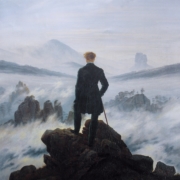Wanderlust
Wanderlust is used in English to describe the desire to travel, usually to explore new and stimulating places. German Romantic literature and art of the late eighteenth and early nineteenth century made much of journeys of discovery, perhaps causing this word to travel into English to fill a void where no word had gone before. A 2018 exhibition in Berlin titled Wanderlust showcases many of these historic works from across the continent, including the above painting Wanderer above the Sea of Fog by German Romantic painter Caspar David Friedrich.
Interestingly contemporary German usage prefers the term Fernweh where English now uses Wanderlust, with Fernweh being the literal opposite of Heimweh, which means homesickness. Fern means distant and Weh is an ache, so this is an aching for some remote destination.
The German noun Lust is a broad and positive term covering enjoyable desire of every kind, and so not really a direct equivalent of the narrow English term lust. The English word lust typically describes a desire that is dangerous or disapproved of such as sexual desire or desire for money. In English lust is used in the Christian religion to denote sexual desire, when occurring outside of approved conditions, as being one of the seven deadly sins which can result in divine punishment.
This confusion about lust is reflected in the titling of a 2012 film Wanderlust, and a 2018 BBC series titled Wanderlust, both dealing with issues of people’s desire wandering from a fixed partner. Traditionally saying a spouse has “a wandering eye” means they look lustfully at people other than their own spouse, often causing tensions and material for drama.




